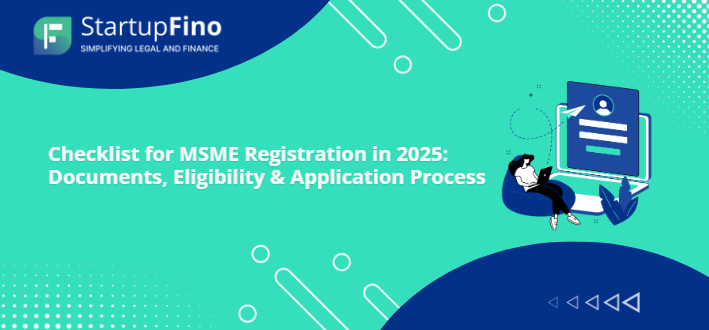Are you starting a small business in 2025 or want to avail the benefits provided by the Indian government for MSMEs? Then the first step to obtaining these government benefits is registering your business under MSME registration.
With the government actively promoting Micro, Small & Medium Enterprises (MSMEs), registering your business can get you incentives including collateral-free loans, tax exemptions and priority in public tenders.
But first you have to understand the process clearly.
In this article, we will explain the MSME Registration Checklist with the needed documents for MSME registration, who’s eligible and how to register MSME online through the official Udyam portal.
What is MSME Registration in India?
MSME means Medium, Small, and Micro Enterprises. These businesses comprise the foundation of the Indian economic system and are responsible for our majority of exports, innovation, and employment.
MSME Registration in India or Udyam registration is a government identification issued to businesses having certain investment and turnover limits.
It’s not compuslsory, but strongly recommended to gain access to benefits like:
- Subsidised loans.
- Tenders from the government.
- Income tax exemptions.
- Convenient access to credit.
Revised MSME Classification (As per 2025 Guidelines)
The government amended the definition of MSMEs to include investment and turnover under the classification criteria.
Here’s how businesses are categorized:
| Enterprise Type | Investment Limit | Turnover Limit |
| Micro Enterprise | Up to Rs. 1 crore | Up to Rs. 5 crore |
| Small Enterprise | Up to Rs. 10 crore | Up to Rs. 50 crore |
| Medium Enterprise | Up to Rs. 50 crore | Up to Rs. 250 crore |
So, if your business fits into any of the above categories, you can apply for MSME registration in India.
Who is Eligible for MSME Registration in India?
MSME registration is not restricted to particular company structures. Almost all kinds of entities can apply.
The eligible applicants are mentioned below :
- Sole Proprietors.
- Partnerships Firms.
- Private Limited Companies.
- Public Limited Companies.
- LLPs (Limited Liability Partnerships)
- Self Help Groups (SHGs)
- Cooperative Societies.
- Trusts.
- Startups & Individual Entrepreneurs.
Note: You must still satisfy the investment and turnover criteria to be eligible.
Complete MSME Registration Checklist (2025) – Documents Required
Before you apply, keep this MSME Registration Checklist ready to avoid delays:
| Document/Info Required | Purpose |
| Aadhaar Card | Identity and authentication of owner |
| PAN Card | Tax verification and linking |
| Business Address Proof | To confirm business location |
| Bank Account Details | Financial verification and communication |
| Business Activity Description | To classify enterprise category and NIC code selection |
| Investment Details | Cost of plant and machinery or equipment |
| Turnover Details | Previous year or projected annual turnover |
| NIC Code (2-digit) | For business classification (for ex., manufacturing/service) |
| Partnership Deed (if applicable) | Proof of business partnership |
| Machinery Purchase Invoices | Proof of capital investment (if applicable) |
| Sales/Purchase Bills | To show business activity has started |
This list covers the most common MSME registration documents needed.
Step-by-Step MSME Registration Process in India (Online via Udyam Portal)
The registration is digital and free of charge. You can easily finish it on your own.
A. For New Entrepreneurs
In case you’re registering for the very first time :.
- Visit Udyam Portal.
- Website : https: / / udyam registration.gov.in.
- Click “For New Entrepreneurs.” (For all those who aren’t yet registered under MSME or Udyog Aadhaar.)
- Enter Aadhaar Number & Name.
- Validate with OTP from mobile associated with Aadhaar.
- Enter PAN & Organisation Type.
- The portal will pull PAN details from the Income Tax database.
- Fill MSME Application Form.
- Name of business.
- Location.
- NIC Code.
- Details of Investment & Turnover.
- Submit Declaration & OTP.
- Tick the declaration box and verify the final OTP.
- Get Udyam Registration Certificate.
- The certificate will be emailed to you upon submission.
B. For Businesses Registered Under Udyog Aadhaar Already
If your business currently has a Udyog Aadhaar (MSME) number, follow these steps:
- Go to the same Udyam site.
- Click on “For those already having registration as UAM”.
- Put in your Udyog Aadhaar number and confirm it by OTP.
- When you see the prompt, fill in updated details.
- Send the form to get your new Udyam Registration Certificate.
How to Register MSME Without Aadhaar?
If you do not have Aadhaar yet, follow these steps:
- Find your local District Industry Centre (DIC).
- Apply manually with assisted filing.
- You will require an Aadhaar Enrollment ID or one of the following:
- Voter ID.
- Driving License.
- Passport.
- Employee ID.
- Bank Passbook.
- After Aadhaar is issued, you can migrate your data online.
What is the Difference Between Udyog Aadhaar and Udyam Registration?
| Udyog Aadhaar (Old System) | Udyam Registration (Current) |
| Required physical documents | Fully digital and self-declared |
| Manual form filling | Online application only |
| Limited validation of data | PAN and GST-linked validation |
| Used until 2020 | In effect from July 1, 2020 onwards |
Also Read | MSME Registration State-Wise Guide: How to Register in Your City
Final Thoughts
Starting or running a business comes with its own set of difficulties in India. However, the Indian government has provided committed assistance to small businesses through MSME registration in India.
With this MSME registration checklist, and after submitting the necessary documents and using the easy Udyam portal, your business will receive its registration and several new growth opportunities.
So, whether you are a startup, a retail store owner, manufacturer or freelancer, registering under MSME might be your best choice in 2025.
Contact our experts at StartupFino for help with MSME registration and get your MSME certificate today.
FAQs
1. What documents are needed for MSME registration?
You need some basic papers and business details to register under MSME (Udyam) in India. They include your Aadhaar card for identity verification and PAN card for tax related authentication. You should also submit business address proof, account info along with a description of your business actions. You need to also have information about your investment in plant & equipment or machinery, and annual turnover figures. In case your business is a partnership or LLP, upload the partnership deed. Sales, purchases and machinery invoices (in case any) might also be required. All this may be submitted online via the Udyam portal.
2. What is the future of MSMEs in India?
The potential future for MSMEs in India appears promising particularly since the federal government offers much more assistance to this sector. Digitization, easier access to finance and programs like the Udyam portal enable MSMEs to scale faster. The government is also offering benefits like local manufacturing, export help, digital lending and priority sector lending. MSMEs are likely to stimulate employment creation, exports and innovation in 2025 and beyond. But how well businesses adopt technology, boost their productivity and comply will determine their success. It seems that MSMEs will continue to form the foundation of India’s economic development over the next decade.
3. What is the MSME registration limit for 2025?
As of 2025, the MSME limits for classification are clearly defined under government norms. The limits are based on investment and turnover:
| Type | Investment Limit | Turnover Limit |
| Micro | Up to Rs. 1 crore | Up to Rs. 5 crore |
| Small | Up to Rs. 10 crore | Up to Rs. 50 crore |
| Medium | Up to Rs. 50 crore | Up to Rs. 250 crore |
In case your business is within these financial limits you are eligible for MSME registration under the Udyam portal. It includes both manufacturing and service businesses.
4. Is GST compulsory for MSME?
No, you don’t need GST registration to get MSME (Udyam) registration unless your small business falls under categories which are mandated by GST law. In case your yearly turnover gets to the GST threshold limit (20 lakh for service businesses and 40 lakh for goods companies) then GST is mandatory. But for MSME registration specifically, you can still register without GST if your turnover is below the threshold. Still, a GST number helps with many tax-related MSME advantages. If you’re uncertain whether your business requires GST registration together with MSME registration, you must talk to one of our experts at StartupFino.
5. How long is MSME registration valid?
MSME Registration (Udyam registration) is for lifetime. When your small business is registered on the Udyam portal, you do not have to renew the certification. But you need to update business information if there are major changes (for instance, turnover, in investment, business structure or contact details). The portal allows updates and in a number of cases verification. Updating your data helps you prevent missing out on MSME-related benefits like subsidies, loan schemes or government tenders. So, although the certificate doesn’t expire, remaining compliant is important.
6. What is the turnover criteria for MSMEs ?
Your yearly business revenue determines the turnover requirements for MSME registration in 2025. According to the government classification:
- Micro Enterprise: Annual turnover not exceeding 5 crore.
- Small Enterprise: Annual turnover not exceeding 50 crore.
- Medium Enterprise: Annual turnover not more than 250 crore.
This turnover covers the gross receipts from business activities along with measures of the operation scale. It’s computed from PAN-linked data pulled by the Udyam portal from Income Tax & GST databases. You must meet both investment and turnover limits to qualify under a particular category for MSME registration.






